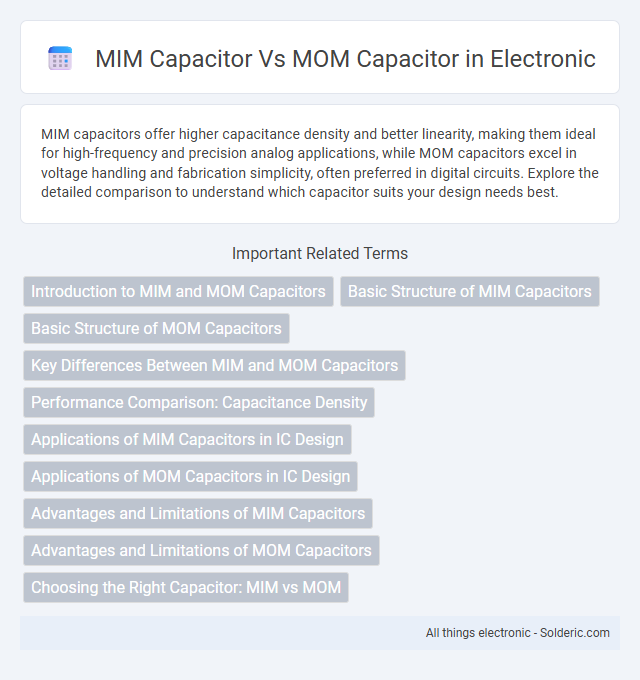MIM capacitors offer higher capacitance density and better linearity, making them ideal for high-frequency and precision analog applications, while MOM capacitors excel in voltage handling and fabrication simplicity, often preferred in digital circuits. Explore the detailed comparison to understand which capacitor suits your design needs best.
Comparison Table
| Feature | MIM Capacitor | MOM Capacitor |
|---|---|---|
| Structure | Metal-Insulator-Metal layered structure | Interdigitated Metal fingers |
| Capacitance Density | High (up to several fF/mm2) | Moderate to low (usually < 1 fF/mm2) |
| Voltage Handling | Lower voltage tolerance | Higher voltage tolerance |
| Parasitic Effects | Lower parasitic resistance and inductance | Higher parasitic resistance and inductance |
| Frequency Performance | Suitable for high-frequency RF applications | Better for lower frequency or analog circuits |
| Process Complexity | Requires precise thin dielectric control | Less process demanding |
| Area Efficiency | More compact | Less compact |
| Typical Applications | RF filters, high-frequency matching networks | Analog signal processing, digital isolations |
Introduction to MIM and MOM Capacitors
MIM (Metal-Insulator-Metal) capacitors consist of two metal electrodes separated by a thin dielectric layer, providing high capacitance density and excellent high-frequency performance. MOM (Metal-Oxide-Metal) capacitors feature interdigitated metal fingers on the same layer with an oxide dielectric, offering simpler fabrication and lower parasitic capacitance. Both capacitor types serve in integrated circuits, with MIM capacitors preferred for precision analog and RF applications due to their linearity and stability.
Basic Structure of MIM Capacitors
MIM capacitors consist of two metal plates separated by a thin dielectric layer, offering high capacitance density and low parasitic resistance. Their basic structure typically involves a sandwich-like configuration with metal-insulator-metal layers precisely stacked to enhance performance in integrated circuits. You benefit from MIM capacitors' stability and reliability in high-frequency applications compared to MOM capacitors, which use interdigitated metal fingers on a single plane.
Basic Structure of MOM Capacitors
MOM capacitors feature an interdigitated structure where metal fingers are alternately connected to the two electrodes, creating a parallel plate effect with lateral capacitance. The metal layers are typically separated by a thin oxide or dielectric layer, optimizing capacitance density and reducing parasitic capacitance. This design offers advantages in fabrication compatibility and scalability compared to the stacked, multilayer structure of MIM capacitors.
Key Differences Between MIM and MOM Capacitors
MIM capacitors (Metal-Insulator-Metal) offer higher capacitance density and better linearity compared to MOM capacitors (Metal-Oxide-Metal), primarily due to their parallel-plate structure and thin dielectric layers. MOM capacitors feature interdigitated metal fingers that provide larger area but lower capacitance density and are typically more tolerant of manufacturing variations. The key differences include MIM capacitors' superior frequency stability and voltage linearity, whereas MOM capacitors excel in ease of integration and cost-effectiveness for certain analog and RF applications.
Performance Comparison: Capacitance Density
MIM capacitors offer significantly higher capacitance density due to their metal-insulator-metal structure, making them ideal for compact, high-frequency applications. MOM capacitors typically provide lower capacitance density but excel in voltage handling and linearity. Your choice depends on whether you prioritize maximizing capacitance within a limited area or require enhanced voltage tolerance and device stability.
Applications of MIM Capacitors in IC Design
MIM capacitors are widely used in RF and analog integrated circuit (IC) design due to their high capacitance density and low parasitic inductance, making them ideal for filters, oscillators, and tunable frequency circuits. They excel in providing stable capacitance over temperature variations and voltage bias, which is critical in precision timing and sensor circuits. Compared to MOM capacitors, MIM capacitors offer better linearity and lower loss, enhancing performance in high-frequency applications like phased array antennas and power management ICs.
Applications of MOM Capacitors in IC Design
MOM capacitors are widely used in integrated circuit (IC) design for applications requiring high linearity and low parasitic capacitance, such as analog and RF circuits. Their interdigitated finger structure offers excellent matching and stability, making them ideal for filters, oscillators, and data converters. MOM capacitors also provide compact layout benefits and are favored for precision timing and sensor interfaces due to their predictable capacitance density.
Advantages and Limitations of MIM Capacitors
MIM (Metal-Insulator-Metal) capacitors offer high capacitance density and excellent linearity, making them ideal for RF and analog applications demanding precision and stability. Their low parasitic resistance and capacitance enhance performance at high frequencies, although fabrication complexity and cost are higher compared to MOM (Metal-Oxide-Metal) capacitors. Limited voltage handling and lower breakdown voltage relative to MOM capacitors represent key constraints in high-power scenarios.
Advantages and Limitations of MOM Capacitors
MOM capacitors offer advantages such as higher capacitance density and easier integration with standard CMOS processes, making them suitable for compact and high-frequency applications. Their fabrication process is typically less complex and more cost-effective compared to MIM capacitors. However, MOM capacitors exhibit higher equivalent series resistance (ESR) and lower quality factor, which can limit performance in precision analog circuits.
Choosing the Right Capacitor: MIM vs MOM
Choosing between MIM and MOM capacitors depends on the required capacitance density and process compatibility; MIM capacitors offer higher capacitance density and better linearity due to their metal-insulator-metal structure. MOM capacitors, built with interdigitated metal fingers, provide simpler fabrication and are suitable for applications needing moderate capacitance with lower voltage sensitivity. Design engineers prioritize MIM capacitors in RF and analog circuits for enhanced performance, while MOM capacitors are often favored in digital ICs for their lower cost and ease of integration.
MIM capacitor vs MOM capacitor Infographic

 solderic.com
solderic.com